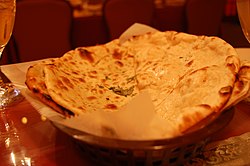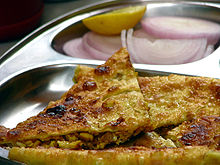Paratha
This article needs additional citations for verification. (August 2007) |
 Mint parantha (Pudina Parantha) from India | |
| Alternative names | Paratha, parauntha, palata, farata, parontay, prontha, |
|---|---|
| Place of origin | Indian Subcontinent |
| Main ingredients | Atta, maida, ghee/butter/cooking oil and various stuffings |
A paratha/parantha/parauntha is a flatbread that originated in the Indian Subcontinent. It is still quite prevalent throughout the area. Parantha is an amalgamation of the words parat and atta which literally means layers of cooked dough.[1] In Burma, it is known as palata (ပလာတာ; pronounced [pəlàtà]), while it is known as farata in Mauritius and the Maldives. However, in areas of the Punjabi region, it is referred to as prontha or parontay.
It is one of the most popular unleavened flat breads in the northern part of the Indian subcontinent and is made by pan frying whole wheat dough on a tava.[2] The parantha dough usually contains ghee or cooking oil which is also layered on the freshly prepared paratha.[3] Paranthas are usually stuffed with boiled potatoes (as in aloo ka parantha), leaf vegetables, radishes, cauliflower, and/or paneer (Cottage-cheese). A parantha (especially a stuffed one) can be eaten simply with a pat of butter spread on top, with chutney, pickles, and yogurt, or with meat or vegetable curries. Some roll the parantha into a tube and eat it with tea, often dipping the parantha.
The parantha can be round, heptagonal, square, or triangular. When it is round, the stuffing is mixed with the kneaded flour, and the parantha is prepared in the same way as roti, but in the latter two forms, the peda (ball of kneaded flour) is flattened into a circle, the stuffing is kept in the middle, and the flatbread is closed around the stuffing like an envelope. The latter two also vary in that they have discernible soft layers, with one "opening" to the crispier shell layers.
History and popularity
The Paratha is an important part of a traditional North Asian breakfast. Traditionally, it is made using ghee but oil is also used. Some people may even bake it in the oven for health reasons. Usually the paratha is eaten with dollops of white butter on top of it. Sides which go very well with paratha are curd, fried egg, omelette, Qeema (Ground beef cooked with vegetable and spices), Nihari (a beef dish), zeera aloo (potatoes lightly fried with cumin seeds), daal, and raita as part of a breakfast meal. It may be stuffed with potatoes, paneer, onions, qeema or chili peppers.
Some sources claim that Parantha originated from ancient Vedic times. The word paratha originated from the Vedic Sanskrit word पुरोढाशम् (pu-ro-dhaa-sham) (purodhasha). Purodhasha's are offered to the fire god during Yajna, Yagna or Homa ceremonies. Vedic purodhashas are usually stuffed with ingredients like powdered lentils and chopped vegetables.[citation needed]Purodhasham for Indra Purodhasham is an unleavened bread
Types







- Ajwain paratha (layered paratha laced with ajwain)
- Aloo paratha (stuffed with spicy boiled potato and onions mix)[4]
- Aloo Cheese Paratha
- Anda paratha (stuffed with spiced egg)
- Bal wala paratha
- Band gobi wala paratha/Patta gobhi paratha (stuffed with cabbage)
- Batuha paratha (Lamb's quarter, Chenopodium album)
- Boondi paratha (stuffed with salty boondi & baked with ghee)
- Ceylon paratha (from Sri Lanka)
- Chana paratha (chick peas)
- Channa dal paratha (stuffed with channa dal) [5]
- Chicken paratha
- Chili parotha/mirchi paratha (small, spicy shredded pieces)
- Dal paratha (stuffed with boiled, spiced and mashed dal mostly available in northwestern and western India)
- Dhaniya paratha (coriander)
- Gajar paratha (carrot)
- Gobhi paratha (stuffed with flavoured cauliflower)
- Jaipuri paratha
- Kerala paratha (popular version pronounced "porotta")
- Lachha paratha - tandoori (Punjabi in origin. Round in shape with multiple layers traditionally prepared in a tandoor)
- Lachha paratha - tawa wali (popular in eastern India, triangular in shape with multiple layers interspaced with ghee)
- Lasuni Paratha (Garlic flavoured)
- Lauki paratha (bottle gourd)
- Makka paratha (corn)
- Mattar paratha (stuffed with boiled, mashed and flavoured green peas)
- Meetha paratha (stuffed with sugar)
- Methi paratha (stuffed with fenugreek leaves)
- Mooli paratha (radish-stuffed paratha, popular in most regions of northern India and the Punjab region of India.) [6]
- Mughlai paratha (a deep fried stuffed paratha filled with egg and minced meat)[7]
- Mutton paratha
- Mix paratha [8]
- Palak paratha (spinach)
- Paneer paratha (stuffed with cottage cheese) [9]
- Parton wala paratha ( Lachha paratha )
- Plain paratha (layered roti without any stuffing except ghee and baked with ghee – popular in most regions of India)
- Podeena paratha (laced with dry mint)
- Putthay taway ka paratha
- Pyaz ka paratha (stuffed with onion)
- Qeema paratha, (stuffed with minced meat (keema), usually mutton, mostly available in Punjab, Hyderabad in India, and Myanmar)
- Roti paratha/prata (Singapore & Malaysia)
- Sattu paratha (stuffed with spiced sattu – roasted gram flour popular in Uttar Pradesh and Bihar) [10]
- Shrimp paratha
- Sugar paratha (layered with caramelized sugar, usually after a meal or as dessert)
- Tandoori paratha
- Tomato paratha (stuffed with tomatoes)
Ready-made varieties
The process of layering the "skins" of dough in a parantha can make preparation a difficult process. This, mixed with the popularity of this flatbread has opened the market to several ranges of frozen paratha – especially in Western markets where consumers seek the authenticity, but lack the time required to make a parantha from scratch.[citation needed] Ready to cook parantha may also be purchased. These preparations offer one-step preparation and save time. Some of the ready-to-cook products in the market are just the stuffings for making the stuffed paranthas.
See also
- Bhatura
- Chili parotha
- Gali Paranthe Wali
- Green onion pancake (Chinese variant)
- Kerala porotta
- Kothu Parotta, the South Indian variant
References
- ^ Mughlai Cook Book - By Neera Verma
- ^ Climbing the Mango Trees - By Madhur Jaffrey
- ^ Breadtime - By Susan Jane Cheney
- ^ Recipe for Aloo Paratha / Flatbread Stuffed with Spiced Potatoes
- ^ Indian Food Channa dal paratha Recipe
- ^ Indian Food Mooli paratha Recipe
- ^ Recipe for Mughlai paratha
- ^ Indian Food Mix paratha Recipe
- ^ Indian Food Paneer paratha Recipe
- ^ Recipe for Sattu paratha





